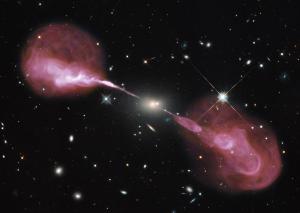Post
Five Misconceptions
About Black Holes
11 December 2012
 NASA, ESA, S. Baum and C. O’Dea (RIT), R. Perley and W. Cotton (NRAO/AUI/NSF), and the Hubble Heritage Team (STScI/AURA)
NASA, ESA, S. Baum and C. O’Dea (RIT), R. Perley and W. Cotton (NRAO/AUI/NSF), and the Hubble Heritage Team (STScI/AURA)1. Black holes are holes in space
Although black holes excite the imagination, on a basic level a black hole is just an object with a very high density. On the surface of the Earth the acceleration due to gravity is “one gee”. If the density of the Earth were larger, either by having greater mass or a smaller size, then the surface gravity would get larger. At really high densities there is a point where the surface gravity becomes so strong that not even light can escape. It is at this critical density that the object becomes a black hole.
2. Black holes have stronger gravity than other objects
If the Earth were one astronomical unit (1 AU) from a black hole the mass of the Sun, it would feel the same gravitational strength as we do from the Sun. In fact the Earth could orbit the solar mass black hole just as it orbits the Sun. What is different is if you get really close to the black hole. As you get closer to an object, its gravitational pull on you increases. For the Sun, as you get closer you would eventually reach the surface. At that distance from the black hole its gravitational strength would be the same as the surface gravity of the Sun. As you get closer to the black hole the gravitational strength would continue to increase. Get closer than the event horizon and you’ll be trapped forever.
3. Black holes lead to other universes
This is a common idea in science fiction. There is a hypothetical structure in general relativity known as a wormhole (or Einstein-Rosen bridge) which would connect one region of space to another, but wormholes in GR collapse on themselves and are not traversable. Barring some yet-discovered exotic physics, we can’t use wormholes as cosmic shortcuts. Still, wormholes and black holes are different things. The only thing a black hole leads to is your inevitable doom.
4. Black holes must be very massive
Most of the black holes we hear about are “supermassive” black holes that lie at the heart of our galaxy and others. These black holes can be a million times more massive than our Sun. But they are only one type of black hole. Star-sized black holes can form when a large star dies, and are sometimes referred to as collapsars. There has even been speculation that tiny “primordial” black holes may have formed soon after the big bang (though there is currently no observational evidence of them).
5. You can’t see a black hole
This stems from the fact that not even light can escape a black hole. But just because an object doesn’t give off light doesn’t mean we can’t detect them. Black holes can be measured by observing their gravitational effect on nearby objects, such as the motion of stars near the center of the Milky Way. Some black holes have superheated accretion disks, and have immense jets of matter shooting away from them. You can see an example of this in the radio image of the galaxy Hercules A, seen above.